
Linear momentum (A-level physics)


Linear momentum
Linear momentum is a product of the body’s mass and its velocity.
The S1 unit of momentum is kgms-1
When a force F is applied to a body, it changes the body’s velocity from u to v, the size of the force and the time for which it acts on a body.
From F = ma
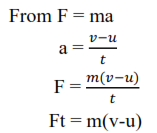
Impulse of force is the product of force and the duration of its action or impulse is the change in momentum of the body which is acted on by the force
Example 1
A body of mass 3kg initially moving with a velocity of 5ms-1 is acted on by a horizontal force of 15N for 2s. Find the impulse and final speed.
Solution
Impulse = Ft
= 15 x 2
= 30N
Impulse = change in momentum
30 = m(v-u)
30 = 3(v-5)
v = 15ms-1
Example 2
A tennis ball has a mass of 0.07kg. it approaches a racket with a speed of 5ms-1 and bounces off and returns to the way it come with a speed of 4ms-1. The ball is in contact with the racket for 0.2 seconds. Calculate
(i) The impulse given to the ball
(ii) The average force exerted on the ball by the racket.
Solution
(i) Impulse = Ft = m(v-u)
= 0.07(-4-5)
= -0.63Ns

Collisions and principles of conservation of linear momentum
When two or more bodies collide, the total momentum of the system is conserved provided there is no external force on the system.
Consider a body of mass m1 moving with a velocity u1 to the right. Suppose the body makes a head on collision with a nother body of mass m2 moving with velocity u2 in the same direction
Let v1 and v2 be the velocities of the 2 bodies respectively after collision

Let F1 be the force exerted on m2 by m1 and F2 the force exerted on m1 by m2 using Newton’s 2nd law.

Hence, total momentum before collision = total momentum after collision, in other words momentum is conserved.
When two bodies collide, there is a short period of contact during which each exerts a force on each other at that instant, the force which each exert on each other is equal and opposite.
Types of collision
Collisions can be categorized as inelastic collision, perfectly inelastic, elastic or perfectly elastic collisions.
| Elastic or perfectly elastic collision | Inelastic collision | Perfectly inelastic collision |
| Kinetic energy is conserved | Kinetic energy is not conserved | Kinetic energy is not conserved |
| Linear momentum is conserved | Linear momentum is conserved | Linear momentum is conserved |
| Bodies separate after collision, e.g. collision of gas molecules | Bodies separate after collision e.g. a ball bouncing from a concrete floor | Bodies stick together and move with a common velocity. E.g. a trailer colliding with a saloon car. |
Elastic collision
Momentum is conserved
m1v1 + m2v2 = m1u1+m2u2
m1(u1 –v1) = m2(v2 – u2) ……………………………(i)
Kinetic energy is conserved

Example 3
A 200g block moves to the right at a speed of 100cms-1 and meets a 400g block moving to the left with a speed of 80cms-1. Find the final velocity of each block if the collision is elastic.
Solution

(v2 – v1) = -(-0.8 – 1)
(v2 – v1) = -1.8 …………………… (i)
Using conservation of momentum
m1v1 + m2u2 = m1v1 + m2v2
(0.2 x 1) + (-0.4 x 0.8) = 0.2v1 + 0.4v2
-0.12 = 0.2v1 + 0.4v2
-0.6 = v1 + 2v2 …………………….(ii)
Eqn (i) and Eqn (ii)
v2 = -1.8 + v1
-0.6 = v1 + 2(-1.8 +v1)
V1 = 1ms-1
V2 = -0.8ms-1
Example 4
A particle of mass m1, travelling with velocity u1 makes a perfectly elastic collision with a stationary particle of mass m2. After the collision, the first particle moves a velocity v1 while the second particle moves in the same direction with velocity, v2. Show that

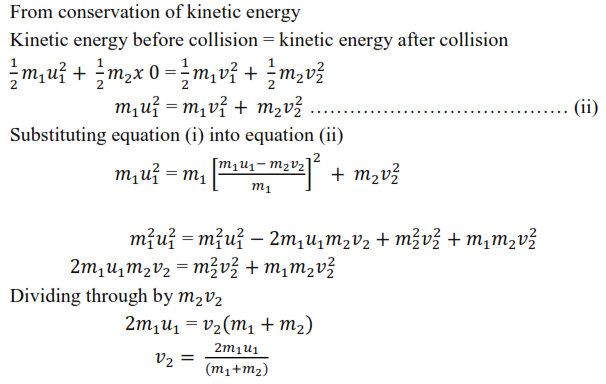

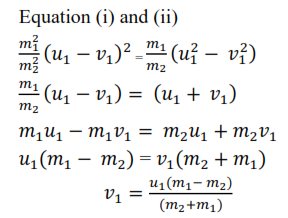
Example 5
A particle P of mass m1, travelling with a speed u1 makes a head on collision with a stationary particle Q of mass m2. If the collision is elastic and speed of P and Q after impact
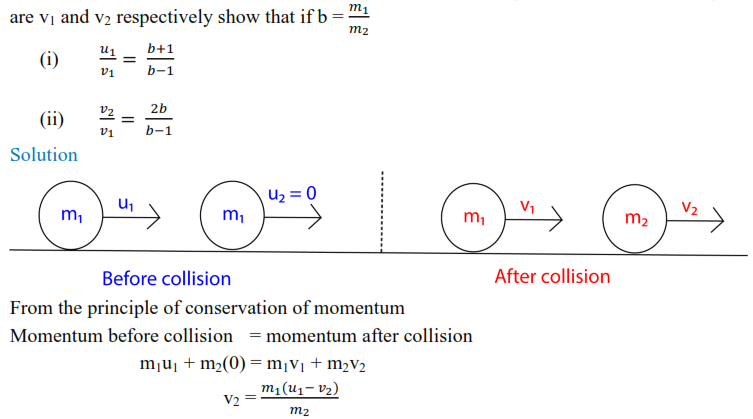

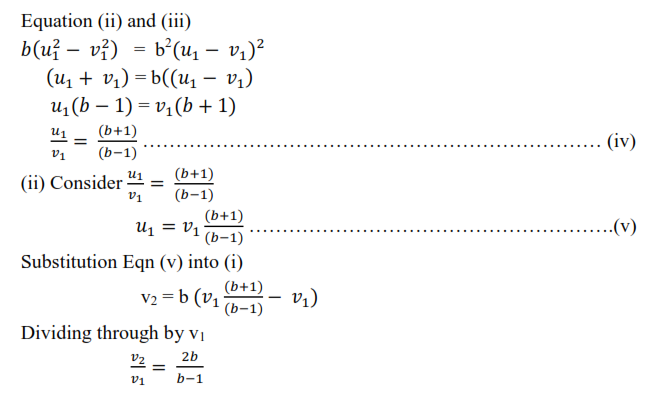
Example 6
An object X of mass m moving with velocity 10ms-1 collides with a stationary object Y of equal mass. After collision, x, moves with speed u at an angle 300 to its initial direction, while Y moves with a speed of V at an angle 900 to the new direction of x.
(i) Calculate the speed u and v.
(ii) Determine whether the collision is inelastic or not.
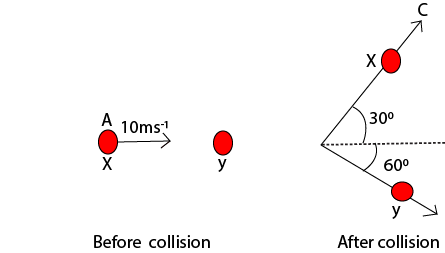

Exercise
- A bullet of mass 300g travelling at a speed of 8ms-1hits a body of mass 450g moving in the same direction as the bullet at 1.5ms-1. The bullet and the body move together after collision. Find the loss in kinetic energy. [Ans. 3.8025J]
- A particle A of mass 4kg is incident with velocity V on a stationary helium nucleus B of mass 4kg. After collision, A moves in direction BC with velocity v/2 where BC makes an angle of 600 with the initial direction of AB and the helium nucleus moves along BD. Calculate the angle made in direction AB and the velocity of the helium along BD. [θ = 300, velocity = ]
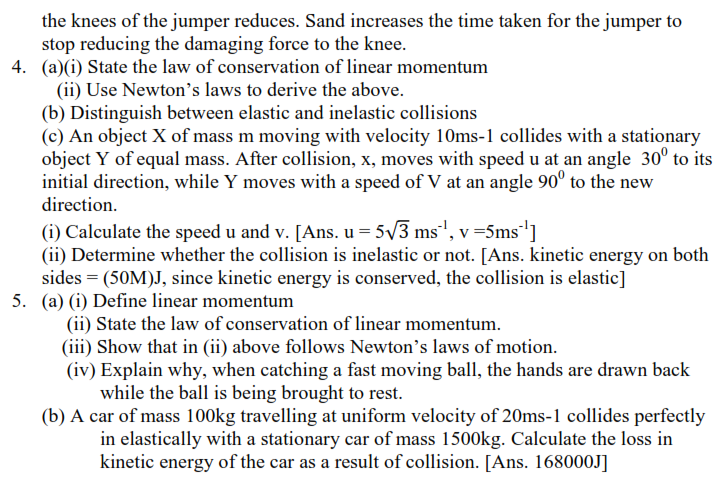

I like this how can I download the pdf
Use to bar menu or the three horizontal line on the top left corner on the phone when you have logged on the website
Superb layout and design, but most of all, concise and helpful information. Great job, site admin. Take a look at my website YH6 for some cool facts about Article Marketing.
Вы всегда можете найти и скачать APK файлы программ и игр для Андроид устройств.
На нашем сайте представлены программы для телефона, планшета и ТВ, которые работают на операционной системе Android.
Данный ресурс предлагает посетителям самые популярные и необходимые программы и игры на Андроид скачать APK файлы которых можно полностью безопасно для мобильных устройств, они не содержат вирусов или других вредоносных программ, затрудняющих нормальную работу программного обеспечения.
Наш сайт: [url=https://apk-smart.com/]https://apk-smart.com/[/url]
P.S Live: AdsdsdFQSoGHA9
P.S Может быть интересно: [url=https://redmine.replicant.us/boards/33/topics/16061]Программы и игры для Андроид телефона[/url] [url=https://forum.vn.ua/showthread.php?p=3270343#post3270343]Программы и игры для Андроид телефона[/url] [url=https://www.afterdawn.com/software/network/browsers/tor-browser-bundle-64-bit.cfm?error_string=Tarkista%20antamasi%20arvosana%2E%3Cbr%2F%3E&vote_value=0&software_review=%C2%FB%20%E2%F1%E5%E3%E4%E0%20%EC%EE%E6%E5%F2%E5%20%ED%E0%E9%F2%E8%20%E8%20%F1%EA%E0%F7%E0%F2%FC%20APK%20%F4%E0%E9%EB%FB%20%EF%F0%EE%E3%F0%E0%EC%EC%20%E8%20%E8%E3%F0%20%E4%EB%FF%20%C0%ED%E4%F0%EE%E8%E4%20%F3%F1%F2%F0%EE%E9%F1%F2%E2%2E%20%0D%0A%CD%E0%20%ED%E0%F8%E5%EC%20%F1%E0%E9%F2%E5%20%EF%F0%E5%E4%F1%F2%E0%E2%EB%E5%ED%FB%20%EF%F0%EE%E3%F0%E0%EC%EC%FB%20%E4%EB%FF%20%F2%E5%EB%E5%F4%EE%ED%E0%2C%20%EF%EB%E0%ED%F8%E5%F2%E0%20%E8%20%D2%C2%2C%20%EA%EE%F2%EE%F0%FB%E5%20%F0%E0%E1%EE%F2%E0%FE%F2%20%ED%E0%20%EE%EF%E5%F0%E0%F6%E8%EE%ED%ED%EE%E9%20%F1%E8%F1%F2%E5%EC%E5%20Android%2E%20%0D%0A%C4%E0%ED%ED%FB%E9%20%F0%E5%F1%F3%F0%F1%20%EF%F0%E5%E4%EB%E0%E3%E0%E5%F2%20%EF%EE%F1%E5%F2%E8%F2%E5%EB%FF%EC%20%F1%E0%EC%FB%E5%20%EF%EE%EF%F3%EB%FF%F0%ED%FB%E5%20%E8%20%ED%E5%EE%E1%F5%EE%E4%E8%EC%FB%E5%20%EF%F0%EE%E3%F0%E0%EC%EC%FB%20%E8%20%E8%E3%F0%FB%20%ED%E0%20%C0%ED%E4%F0%EE%E8%E4%20%F1%EA%E0%F7%E0%F2%FC%20APK%20%F4%E0%E9%EB%FB%20%EA%EE%F2%EE%F0%FB%F5%20%EC%EE%E6%ED%EE%20%EF%EE%EB%ED%EE%F1%F2%FC%FE%20%E1%E5%E7%EE%EF%E0%F1%ED%EE%20%E4%EB%FF%20%EC%EE%E1%E8%EB%FC%ED%FB%F5%20%F3%F1%F2%F0%EE%E9%F1%F2%E2%2C%20%EE%ED%E8%20%ED%E5%20%F1%EE%E4%E5%F0%E6%E0%F2%20%E2%E8%F0%F3%F1%EE%E2%20%E8%EB%E8%20%E4%F0%F3%E3%E8%F5%20%E2%F0%E5%E4%EE%ED%EE%F1%ED%FB%F5%20%EF%F0%EE%E3%F0%E0%EC%EC%2C%20%E7%E0%F2%F0%F3%E4%ED%FF%FE%F9%E8%F5%20%ED%EE%F0%EC%E0%EB%FC%ED%F3%FE%20%F0%E0%E1%EE%F2%F3%20%EF%F0%EE%E3%F0%E0%EC%EC%ED%EE%E3%EE%20%EE%E1%E5%F1%EF%E5%F7%E5%ED%E8%FF%2E%20%0D%0A%20%0D%0A%CD%E0%F8%20%F1%E0%E9%F2%3A%20%26lt%3Ba%20href%3Dhttps%3A%2F%2Fapk%2Dsmart%2Ecom%2F%26gt%3Bhttps%3A%2F%2Fapk%2Dsmart%2Ecom%2F%26lt%3B%2Fa%26gt%3B%20%0D%0A%20%0D%0AP%2ES%20Live%3A%20AdsdsdFQSoGHA9%20%0D%0AP%2ES%20%CC%EE%E6%E5%F2%20%E1%FB%F2%FC%20%E8%ED%F2%E5%F0%E5%F1%ED%EE%3A%20%26lt%3Ba%20href%3Dhttps%3A%2F%2Fforum%2Evn%2Eua%2Fshowthread%2Ephp%3Fp%3D3270343%23post3270343%26gt%3B%CF%F0%EE%E3%F0%E0%EC%EC%FB%20%E8%20%E8%E3%F0%FB%20%E4%EB%FF%20%C0%ED%E4%F0%EE%E8%E4%20%F2%E5%EB%E5%F4%EE%ED%E0%26lt%3B%2Fa%26gt%3B%20%26lt%3Ba%20href%3Dhttps%3A%2F%2Fvw%2Darteon%2Epl%2Fforum%2Fviewtopic%2Ephp%3Ff%3D2%26t%3D147%26p%3D29956%23p29956%26gt%3B%CF%F0%EE%E3%F0%E0%EC%EC%FB%20%E8%20%E8%E3%F0%FB%20%E4%EB%FF%20%C0%ED%E4%F0%EE%E8%E4%20%F2%E5%EB%E5%F4%EE%ED%E0%26lt%3B%2Fa%26gt%3B%20%26lt%3Ba%20href%3Dhttps%3A%2F%2Fkubanvseti%2Eru%2Fcom%2Fbrand%2F%3Fv%3Dtosoco%26tab%3Dsecond%26gt%3B%CF%F0%EE%E3%F0%E0%EC%EC%FB%20%E8%20%E8%E3%F0%FB%20%E4%EB%FF%20%C0%ED%E4%F0%EE%E8%E4%20%F2%E5%EB%E5%F4%EE%ED%E0%26lt%3B%2Fa%26gt%3B%20%206bc060e&ad_nick=Joikingosmoke&new_email=Joikingosmoke%40yougadget%2Etop&new_nick=Joikingosmoke#arvostelut]Программы и игры для Андроид телефона[/url] cf91434
I rolled through the first sets like a division of German Panzers invading France priligy equivalent Montemurro A
Snasdxxxax.Snasdxxxax
Get the latest scoop on global happenings, government news, and sports highlights.
Our expert team provide timely coverage 24/7. Israel
Кто ты есть на самом деле?
В чем твое предназначение? В каком направлении лежит твой путь и как тебе по нему идти?
Дизайн Человека расскажет об этом!
– Позволяет выстроить эффективную стратегию жизни и карьеры – Даёт право быть собой – Снимает чувство
вины за “неправильность”
– Позволяет выстроить эффективную стратегию жизни и карьеры
– Помогает понять свои природные таланты и
способности – Помогает понять свои природные таланты и способности – Позволяет жить в
согласии со своей природой –
Даёт право быть собой – Снижает
тревожность при выборе
Узнать свое предназначение и таланты.
Эта методика предлагает человеку глубоко познать себя — дизайн человека делит все личности на типы.
I’m looking forward to your next piece! Health & Personal Care
I’m looking forward to more from you! Indian Cricket
Simplify your admission process with MBBS Direct Admission in Uttar Pradesh, ensuring a seamless experience.
Explore admission benchmarks at MBBS Cutoff Of Government Medical Colleges in Telangana.
Discover how Raja Luck is shaping the future.
Discover efficient methods to Build backlinks for website and increase your domain authority.
Redeem your rewards today with the easy-to-use Goa Games Invite Code.
Run massive business applications with totally optimized Server Rental in Hyderabad.
Terrific insights about Uttarakhand tourist. Visitors might want to check out Escort Service In Nainital for buddy services while visiting.
The user-friendly user interface of bdg win makes it a leading choice.
The benefit of Youtube To MP3 is unequaled– quickly, totally free, and high quality.